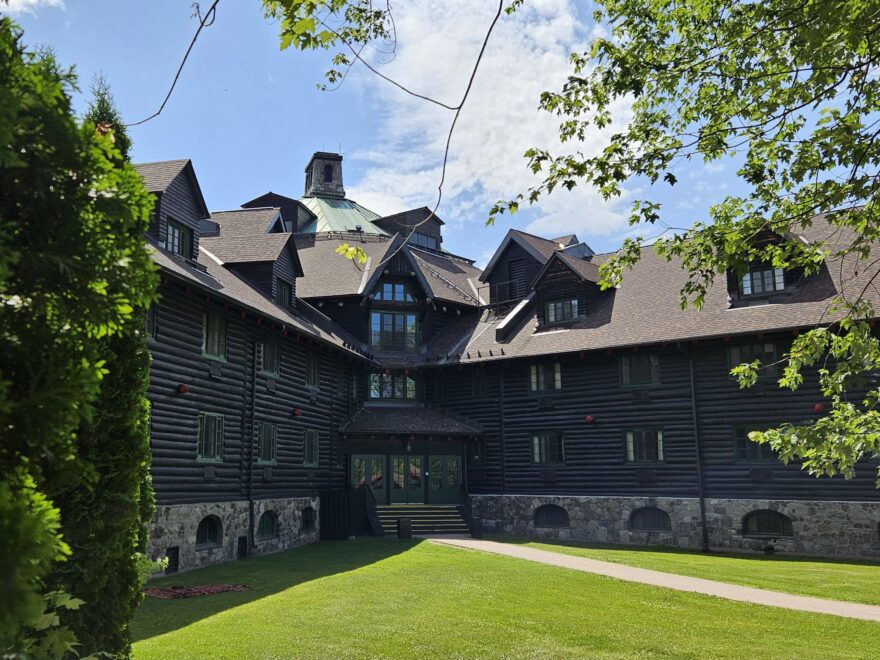I arrived this afternoon at the stunning Château Montebello hotel, built almost a hundred years ago by the Canadian Pacific Railway Company as one of Canada’s ‘grand railway hotels’. This designation includes The Algonquin in St. Andrews (NB), the castle-like Château Frontenac in Québec City, the eponymous Château Lake Louise (Alberta), the Empress Hotel in Victoria (BC), and many others in scenic areas across this huge country.
The hexagonal main building of the Château Montebello was hewn from 10,000 red cedar logs, hauled across the country by rail from British Columbia to Québec – an advantage of the hotel’s builders also owning the railroad.
Before I describe this hotel any further, there’s another part of its history – and of Canadian railroads’ – that’s often omitted from news stories and posts like mine.
That’s the fact that for many Indigenous People, the “railroads are a symbol of dispossession and colonial control that goes back generations.”
A story of repeated “theft of land, starvation, forced relocation”, because the railroads were “one of the most effective tools in the colonization of Canada.”
So I can’t write about the Château Montebello, or other ‘Canada’s ‘grand railway hotels’, without acknowledging that “the link between railways and the removal of Indigenous land is at the root of Canada’s national story.”
[As a good starting point to learn more on this history, I suggest this 2020 article in The Globe & Mail, which I quoted above:
For many of the First Nations… railroads are a symbol of dispossession and colonial control that goes back generations. Here’s a primer on that history”, in The railways got very wealthy on our land’, by Eric Andrew-Gee, The Globe and Mail, 03 Mar 2020.
As for the architecture of the hotel, which opened in 1930, visitors enter through its distinctive circular lobby topped by a three-story high log-construction ceiling, with a massive six-sided stone fireplace and 20 metre (65 foot) high stone chimney at its centre. Described as a ‘true Canadian experience’ on various websites, it’s considered to be the world’s largest ‘log cabin’ and sits on the shore of the Ottawa River.
Although I packed my sketchbook, I don’t think I’ll have much time for my art practice this week as I’m not here on vacation. I’ll be here through Friday as a volunteer Patient Partner at the North American Pain School (NAPS), helping pain researchers learn about patient perspectives on pain and chronic pain – and among Veterans and Disabled persons as I fall into those two groups.
Due to my background in bioethics and research ethics, I’ll also be championing patient engagement in research – in particular in basic science settings, where patients are sometimes an afterthought.
What exactly is NAPS? The website notes that: “The North American Pain School, or NAPS, brings together leading experts in the fields of pain research and management to provide a unique educational and networking experience for the next generation of basic science and clinical pain researchers.
We offer opportunities for scientific education, professional development, and connections with peers in a setting far removed from the lab and steeped in the character and culture of Quebec.
Yearly programs will have a different theme and will bring together 30 trainees with six dynamic, internationally recognized pain investigators from around the world and NAPS permanent faculty for an intensive… workshop.”
We have a packed schedule of meetings, presentations, and workshops focused on research into pain and chronic pain, geared towards “NAPSters”; the early-career researchers (doctoral students, post-doctoral fellows, and clinician-scientists from around the world, but mostly based at Canadian universities and research centres).
On that note, I should get going as we have a ‘meet and greet’ cocktail at 1630, followed by the Opening Remarks, Patient Partner Intros (including my 10-minute speech), a half-hour lecture, dinner, and then “ice-breaker games” from 2030 to 2130.
Tomorrow morning the day begins with a guided group yoga session at 0700, outdoors and overlooking the river, then continues through to a workshop ending at 2100 – topped off with a bonfire outside from 2115 to 2300.
I’ve warned the organizers that I’ll almost certainly have to miss occasional sessions, due to my Mild Cognitive Impairment (my Disability), to let my brain ‘rest’, but I’ll aim sessions in which a patient perspective is less important; for example workshops on ‘academic negotiations’ and ‘managing a research program’.
Of special note, the other Patient Partner here this week is also in the arts, American contemporary abstract artist (and hand-painted fashion designer) Quána Madison, so I’m looking forward to meeting her. My own journey into watercolour painting and sketching began specifically because of my chronic pain from a rare disease (Complex Regional Pain Syndrome or CRPS), so I’m curious to find out whether she was already an artist or became drawn (pun intended!) to creativity after the onset of her pain condition(s).
As always, keep well and stay safe. Feel free to comment over on social media, as the Comment feature here is too inundated with foreign spam to be usable with my cognitive challenges.

